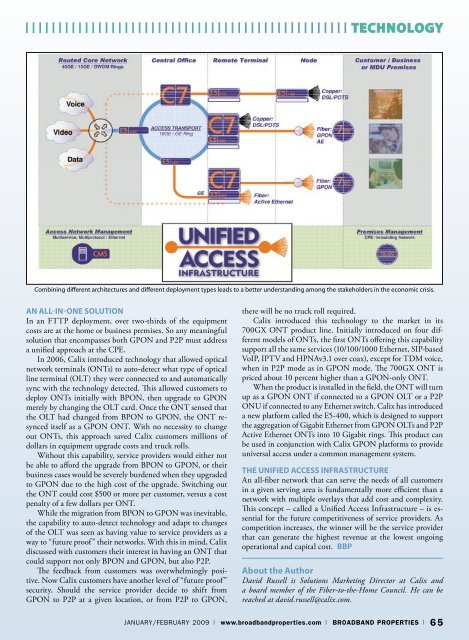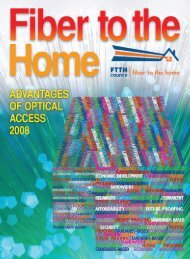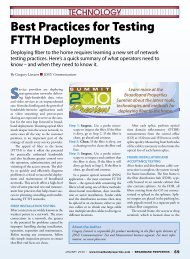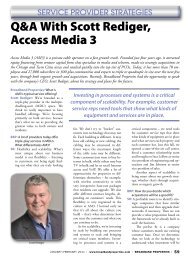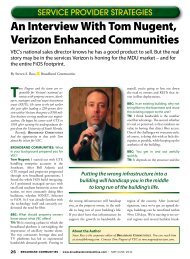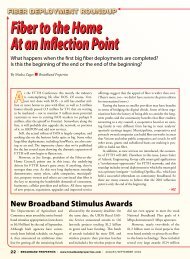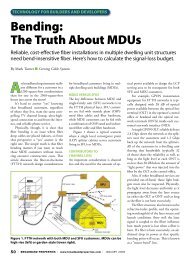bbpmag.com - Broadband Properties
bbpmag.com - Broadband Properties
bbpmag.com - Broadband Properties
Create successful ePaper yourself
Turn your PDF publications into a flip-book with our unique Google optimized e-Paper software.
TECHNOLOGY<br />
Combining different architectures and different deployment types leads to a better understanding among the stakeholders in the economic crisis.<br />
An All-in-One Solution<br />
In an FTTP deployment, over two-thirds of the equipment<br />
costs are at the home or business premises. So any meaningful<br />
solution that en<strong>com</strong>passes both GPON and P2P must address<br />
a unified approach at the CPE.<br />
In 2006, Calix introduced technology that allowed optical<br />
network terminals (ONTs) to auto-detect what type of optical<br />
line terminal (OLT) they were connected to and automatically<br />
sync with the technology detected. This allowed customers to<br />
deploy ONTs initially with BPON, then upgrade to GPON<br />
merely by changing the OLT card. Once the ONT sensed that<br />
the OLT had changed from BPON to GPON, the ONT resynced<br />
itself as a GPON ONT. With no necessity to change<br />
out ONTs, this approach saved Calix customers millions of<br />
dollars in equipment upgrade costs and truck rolls.<br />
Without this capability, service providers would either not<br />
be able to afford the upgrade from BPON to GPON, or their<br />
business cases would be severely burdened when they upgraded<br />
to GPON due to the high cost of the upgrade. Switching out<br />
the ONT could cost $500 or more per customer, versus a cost<br />
penalty of a few dollars per ONT.<br />
While the migration from BPON to GPON was inevitable,<br />
the capability to auto-detect technology and adapt to changes<br />
of the OLT was seen as having value to service providers as a<br />
way to “future proof” their networks. With this in mind, Calix<br />
discussed with customers their interest in having an ONT that<br />
could support not only BPON and GPON, but also P2P.<br />
The feedback from customers was overwhelmingly positive.<br />
Now Calix customers have another level of “future proof”<br />
secur ity. Should the service provider decide to shift from<br />
GPON to P2P at a given location, or from P2P to GPON,<br />
there will be no truck roll required.<br />
Calix introduced this technology to the market in its<br />
700GX ONT product line. Initially introduced on four different<br />
models of ONTs, the first ONTs offering this capability<br />
support all the same services (10/100/1000 Ethernet, SIP-based<br />
VoIP, IPTV and HPNAv3.1 over coax), except for TDM voice,<br />
when in P2P mode as in GPON mode. The 700GX ONT is<br />
priced about 10 percent higher than a GPON-only ONT.<br />
When the product is installed in the field, the ONT will turn<br />
up as a GPON ONT if connected to a GPON OLT or a P2P<br />
ONU if connected to any Ethernet switch. Calix has introduced<br />
a new platform called the E5-400, which is designed to support<br />
the aggregation of Gigabit Ethernet from GPON OLTs and P2P<br />
Active Ethernet ONTs into 10 Gigabit rings. This product can<br />
be used in conjunction with Calix GPON platforms to provide<br />
universal access under a <strong>com</strong>mon management system.<br />
The Unified Access Infrastructure<br />
An all-fiber network that can serve the needs of all customers<br />
in a given serving area is fundamentally more efficient than a<br />
network with multiple overlays that add cost and <strong>com</strong>plexity.<br />
This concept – called a Unified Access Infrastructure – is essential<br />
for the future <strong>com</strong>petitiveness of service providers. As<br />
<strong>com</strong>petition increases, the winner will be the service provider<br />
that can generate the highest revenue at the lowest ongoing<br />
operational and capital cost. BBP<br />
About the Author<br />
David Russell is Solutions Marketing Director at Calix and<br />
a board member of the Fiber-to-the-Home Council. He can be<br />
reached at david.russell@calix.<strong>com</strong>.<br />
January/February 2009 | www.broadbandproperties.<strong>com</strong> | BROADBAND PROPERTIES | 65


